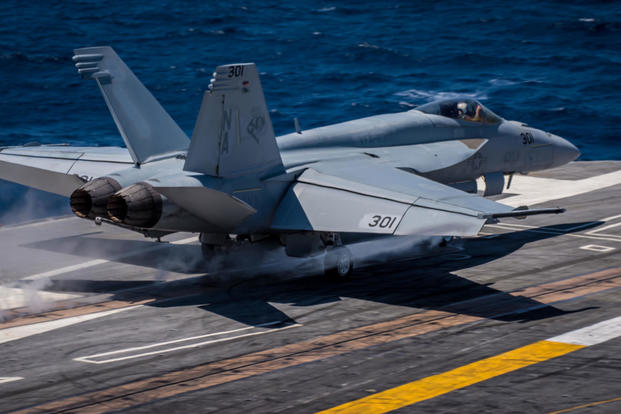The newest weapon in the Navy's fight to prevent physical episodes that endanger fighter pilots in the cockpit is an off-the-shelf watch that can measure air pressure and altitude.
Military.com has learned that the Navy plans to equip every pilot who flies an F/A-18 Hornet or E/A-18G Growler a Garmin Fenix 3 watch, a sleek wrist-wearable device that retails for around $450. Navy Air Forces Commander Vice Adm. Mike Shoemaker released a message to the force in January announcing that he had authorized the devices for deploying strike fighter squadrons 34 and 37, which both fly the older F/A-18C Hornet, rather than the E/F Super Hornet.
Since then, the Navy has ordered enough of the watches for all Hornet and Growler squadrons, Naval Air Forces spokeswoman Cmdr. Jeannie Groeneveld told Military.com Thursday.
"We aim to have 100 percent of our fleet squadrons equipped with the watches by August," she said via email.
Related content:
- Cockpit Oxygen Episodes Sideline Navy Pilots Fighting ISIS
- Air Force: No Clear Cause for F-35A Hypoxia-Related Problem
- Equipment Guide: F/A-18C/D Hornet
The revelation comes the same day the Navy released a 69-page report about physiological episodes that have affected the crews of Hornets, Growlers, and T-45 Goshawk trainers. Commissioned after the Navy ordered a pause in T-45 training flights due to a spike in cockpit episodes, the report offers abundant data, but few solutions.
Documents released alongside the report show that the Hornet and Growler communities saw a record spike in episodes in 2016, with 125 incidents reported. Data for 2017 suggests another notable year, with 52 incidents reported just since January.
For the T-45, cockpit episodes spiked in 2015 and have stayed high since, with a record number, 36, in 2016, and 21 so far this year. March 2017 was a record month for T-45 incidents, with ten reported across the three training units that fly the aircraft.
While those in the T-45 community have speculated that mysterious hypoxia-like episodes in the cockpit are caused by a contaminant on the aircraft's onboard oxygen generation system, most F/A-18 episodes have been attributed to environmental control system issues and cabin pressurization malfunctions, according to the report.
And that's where the watches may come in handy.
The watches, the report notes, were purchased for all F/A-18 crew based in Naval Air Station Oceana, Virginia, because the cabin altimeter gauge of their aircraft was difficult to read due to its size and location, and "its audible warnings are ineffective through the flight envelope."
The watches, once issued to pilots, will alert them when cabin altitude reaches a preset threshold, Navy spokeswoman Lt. Kara Yingling told Military.com. Essentially, the devices could provide pilots with an additional early warning to prevent cabin pressure problems from reaching a crisis point.
Military.com first reported in May that some Hornet pilots were wearing the watches while deployed to the Middle East to conduct airstrikes on Islamic State targets in Iraq and Syria. Capt. James McCall, commander of Carrier Air Wing 8 deployed aboard the carrier George H. W. Bush, said the idea had originated with the crew of VFA-37. The Navy then authorized them to wear the devices, he said.
"I can't speak to the Navy enterprise, their intention to do that for all type-model-series, but I know our guys wear them and like the capability they provide," McCall said.
As of May, two Hornet pilots assigned to the Bush had experienced physiological episodes during missions, McCall said at the time. They were treated using another innovation: a recompression chamber that deployed aboard the Bush for just that purpose.
The altimeter watch concept does have its detractors, however.
"These watches have not undergone [Naval Air Systems Command] testing for accuracy and dynamic range for this application," the authors of the new report warn. "NAVAIR engineers expressed concern these watches could provide a false sense of security."
Navy officials continue to look for ways to solve the problem of physiological episodes -- an issue that has claimed the lives of four Hornet pilots over the course of decades, according to recently released data.
Vice Chief of Naval Operations Adm. Bill Moran, who ordered the recent review, told reporters Thursday that a slew of efforts were still underway to detect existing problems and to ensure that onboard oxygen generation systems were providing pilots with clean, dry, non-contaminated air. If all else fails, the Navy may order aircraft to be equipped across the board with a new, next-generation onboard oxygen generation system, Moran said.
We have been dealing with hypoxic events in naval aviation for as long as we've had high-performance jets," Moran said. "What we're seeing, though, is a trend in the wrong direction."
-- Hope Hodge Seck can be reached at hope.seck@military.com. Follow her on Twitter at @HopeSeck.





























